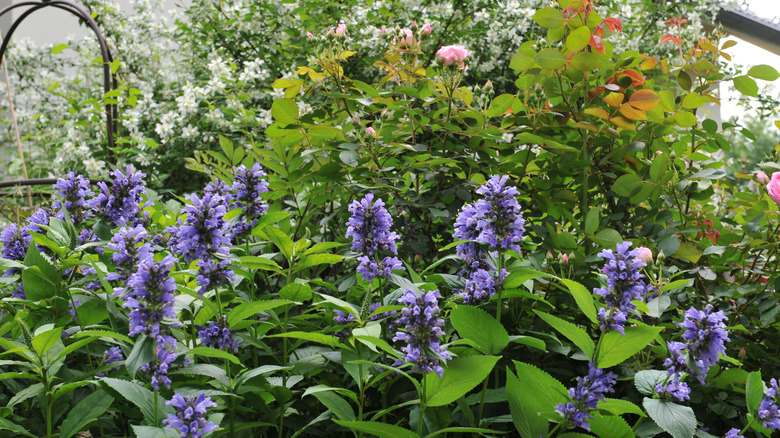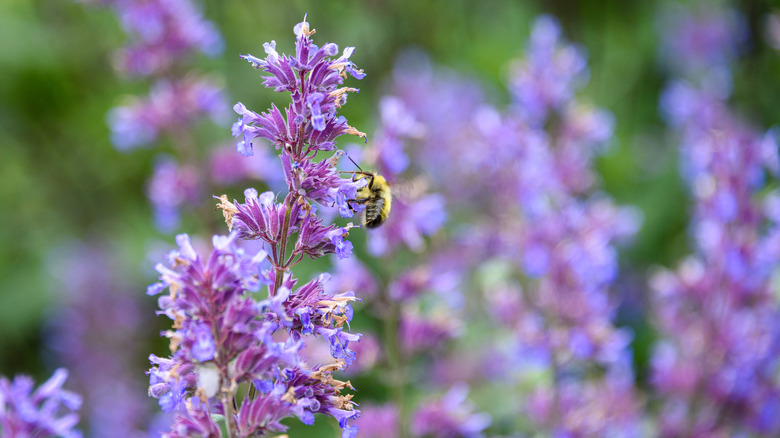Growing Catmint Near Your Rose Bushes Has One Major Benefit
Rose bushes are the pride of many gardens, yet they also come with their own unique challenges and drawbacks. Using companion planting is one way to work smarter instead of harder in the garden, and growing rose bushes is no exception. By carefully selecting which plants to grow alongside rose bushes, you can rid your flower garden of common problems and even make it more visually appealing. One of many major benefits of growing catmint near your rose bushes is that catmint (Nepeta) can hide the legginess and possible blemishes near the bottom of your rose bush, leading to a more attractive rose garden.
There are many different rose bush types, but most of them prefer to be planted in full sun and well-draining soil, just like catmint. Depending on the type of rose bushes you're caring for, you may notice that the edges and top of your rose bush are vibrant and colorful thanks to the lovely blooms, while the bottom section looks like a tangle of thorns and unsightly details. Since most people grow roses to enjoy looking at them, smelling them, and perhaps cutting them for bouquets, it's helpful to know how to cover up the least beautiful areas of the rose bush. Catmint adds contrasting colors and offers various benefits to your rose bushes without competing for soil nutrients.
How to grow catmint near roses
Give your rose bushes at least a 2-foot radius in order to allow the roots to thrive, then plant catmint from seed or by transplanting an existing section. To get the intended visual effect and to take advantage of the additional benefit of using catmint as a living mulch for your rose bushes, plant them as close as you can without interrupting any roots. This way, the catmint will choke out potential weeds while providing shade and moisture retention for the roots of your rose bushes.
Once it's established, catmint is tolerant to drought and doesn't need much maintenance. It's also tolerant to cold and is a hardy perennial in USDA agricultural zones 3 through 8. After it finishes blooming and the gorgeous purple-blue flowers begin to die, cut back catmint and enjoy the second bloom and new growth. The minty leaves are an edible herb. Keep in mind that, as a member of the mint family, catmint spreads very easily. To prevent it from taking over, you can grow it in a low container or you can remove a bit of the plant as needed each year. Give extra parts away or use them in another border or as ground cover. Removing the flowers before they land back in your soil will help prevent expansion through self-seeding, and you can redistribute those seeds in another area of your garden if desired.
Additional benefits of planting catmint near roses
On top of being visually pleasing and acting as a mulch, catmint offers several other benefits when grown near rose bushes. Catmint helps attract pollinators like butterflies and bees, which are not only lovely to look at but also play an important role in the health of your rose bushes and many other plants in your garden. Better yet, catmint repels damaging insects like squash bugs and aphids. Many types of aphids feed on roses, so this protection can help you keep your rose bushes even more beautiful and free from unfortunate holes.
From an aromatic standpoint, growing catmint near your roses will contribute to a beautifully refreshing scent. As the name suggests, catmint has a minty aroma that is generally attractive to humans (and, of course, cats!). The scent itself also provides another important benefit: it helps repel furry creatures that can cause problems for your roses and your garden as a whole, including mice and bunnies. If you grow your roses near your house, this companion planting combination is an excellent way to naturally repel mice from your home. As the cherry on top, catmint also has calming properties, leading many people to use the minty leaves to make teas and essential oils.


